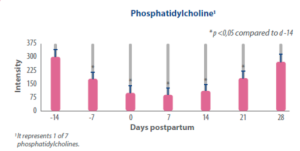
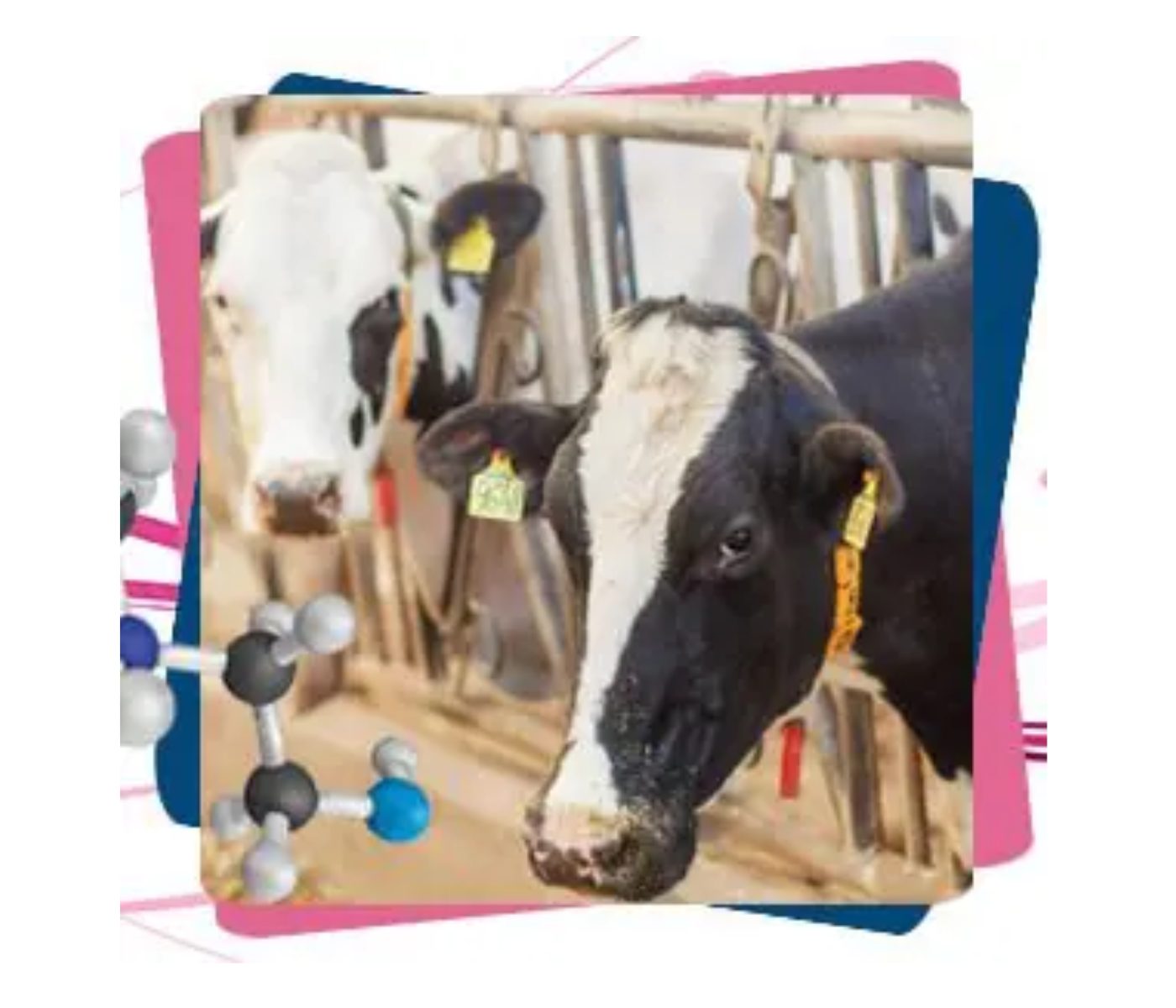 17 Nov 2023
17 Nov 2023
Choline: An Ally Against Fatty Liver and Ketosis
The ability of dairy cows to adapt to negative energy balance (NEB) during the early days of lactation is a crucial factor in milk production since demands cannot be met by food intake alone (Herdt et al., 2000).
 |
One of these disorders is hyperketonemia or ketosis, which develops due to a poor adaptive response to negative energy balance when the liver is saturated with the accumulation of non-esterified fatty acids (NEFAs).
Due to the low energy intake during the transition stage, the body starts mobilizing body fat reserves, increasing the concentration of NEFAs and beta-hydroxybutyrate (BHBA) in the blood (Li et al., 2016).
This metabolic disorder can be classified based on blood BHBA concentrations:
![]() Clinical ketosis: BHBA > 1.2 mmol/l
Clinical ketosis: BHBA > 1.2 mmol/l
![]() Subclinical ketosis: BHBA = 0.8-1.2 mmol/l
Subclinical ketosis: BHBA = 0.8-1.2 mmol/l
 The prevalence in high-production animals can reach up to 15% and 60% for clinical and subclinical ketosis, respectively. The prevalence in high-production animals can reach up to 15% and 60% for clinical and subclinical ketosis, respectively. |
A significant consequence of ketosis in cattle is a reduction in milk production, leading to a potential loss of up to 7% over the entire lactation period.
 The impact of ketosis depends on BHBA concentration:
The impact of ketosis depends on BHBA concentration:


Another significant consequence of ketosis is the culling of animals, with documented reports indicating a threefold rise in the risk of disposal for animals exhibiting ketosis.
 For every 0.1 mmol/l above 1.2 mmol/l increase in BHBA, the risk of discarding an animal increases 1.4 times (J. A. A. McArt et al., 2012). For every 0.1 mmol/l above 1.2 mmol/l increase in BHBA, the risk of discarding an animal increases 1.4 times (J. A. A. McArt et al., 2012). |
In terms of reproduction, it has been demonstrated that blood BHBA concentrations surpassing 1.2 mmol/l during the initial week postpartum can:
 Increase the risk of abomasal displacement up to 7 times
Increase the risk of abomasal displacement up to 7 times Increase the risk of metritis by 3.4 times
Increase the risk of metritis by 3.4 times Decrease fertility in the first service
Decrease fertility in the first service(Otzel & McGuirk, 2010)
In general, the costs stemming from ketosis include:
![]() Clinical problems such as metritis or abomasal displacements (35%)
Clinical problems such as metritis or abomasal displacements (35%)
![]() Reproductive problems (28%)
Reproductive problems (28%)
![]() Losses in milk production (22%)
Losses in milk production (22%)
![]() Culling (13%)
Culling (13%)
The economic impact of ketosis amounts to €256.71 per animal (Deniz et al., 2020).
| Therefore, it is crucial to stimulate liver function to prevent these disorders, and this is where choline plays a fundamental role. |

![]() CHOLINE, AN ESSENTIAL NUTRIENT
CHOLINE, AN ESSENTIAL NUTRIENT
Choline is an essential nutrient for ruminants, participating in various physiological processes such as lipid metabolism and transport.
 It is essential for the synthesis of the primary phospholipid in ruminants, phosphatidylcholine, which is involved in the absorption and transportation of lipids (Zeisel y Da Costa, 2009). It is essential for the synthesis of the primary phospholipid in ruminants, phosphatidylcholine, which is involved in the absorption and transportation of lipids (Zeisel y Da Costa, 2009). |
Phosphatidylcholine plays a crucial role as a vital component in the formation of low-density lipoproteins (VLDL), responsible for removing fats from the liver. This function is particularly crucial during the transition period when the cow experiences a decline in body condition score(BCS) (Yao & Vance, 1988).
Every cow experiences a decrease in body condition score (BCS) during the initial 30 days in milk (DIM), and the criterion for recognizing BCS loss is in the range of 0.5% to 0.75%. This equates to 40.55 kg of fat and protein (with one unit averaging 70 kg, depending on the cow’s size).

Graph 1. Concentration of phosphatidylcholine in plasma of dairy cows around calving (Imhaslv et al., 2015).
 More than 50% of cows in early lactation develop moderate or severe fatty liver (Bobe et al., 2004; Lima et al., 2012). More than 50% of cows in early lactation develop moderate or severe fatty liver (Bobe et al., 2004; Lima et al., 2012). The liver weighs 9 kg and can accumulate more than 450 g of fat the day after calving(Drackley, 2001). A one-point decrease in body condition score will result in 4.5 – 5.5 kg of fat accumulating in the liver! |
 A decline in liver function induces ketosis in the cow.
A decline in liver function induces ketosis in the cow.
It is worth mentioning that, while the animal is in a state of negative energy balance (NEB), choline levels in the blood are at their lowest concentrations during the initial weeks of production (Arshad et al., 2020).
Hence, it is crucial to provide the animal with a protected choline source to prevent its degradation by the microbial population, enabling absorption in the intestine.
Protected choline:
![]() Improves the mobilization of energy reserves and reduces the risk of ketosis
Improves the mobilization of energy reserves and reduces the risk of ketosis
![]() Increases glycogen concentration in the liver
Increases glycogen concentration in the liver
![]() Facilitates improved oxidation of fatty acids
Facilitates improved oxidation of fatty acids
![]() Diminishes the incidence of health issues and enhances reproductive and production outcomes
Diminishes the incidence of health issues and enhances reproductive and production outcomes
(Jayapraksh et al., 2016)

 Research has shown that by supplementing with protected choline during the transition period, dry matter intake can increase by as much as 0.5 kg/day. Furthermore, animals supplemented with protected choline during the initial days in milk (DIM) exhibited a weight gain of 30 kg. Research has shown that by supplementing with protected choline during the transition period, dry matter intake can increase by as much as 0.5 kg/day. Furthermore, animals supplemented with protected choline during the initial days in milk (DIM) exhibited a weight gain of 30 kg. |
Findings from the same study indicate that, through the supplementation of protected choline, milk production can see an increase of up to 1.6 kg/day (even 2 kg/day), particularly when paired with protected methionine.

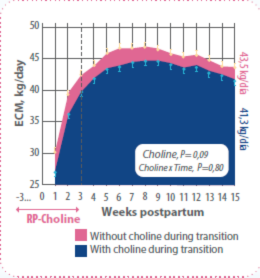
Graph 2. Lactation curve of cows supplemented with and without protected choline (Zenobi et al., 2018 – JDS 101:1088).
 The benefits of supplementing with choline during the transition period go beyond the first 21 days postpartum, as cows maintain a higher production level during the post-supplementation lactation stage.
The benefits of supplementing with choline during the transition period go beyond the first 21 days postpartum, as cows maintain a higher production level during the post-supplementation lactation stage.
 Recent studies have demonstrated that supplementing choline during the prepartum period has a favorable impact on the subsequent generation. Cows subjected to this supplementation exhibit increased colostrum production with a higher concentration of IgG (Zenobi et al,. 2018). Recent studies have demonstrated that supplementing choline during the prepartum period has a favorable impact on the subsequent generation. Cows subjected to this supplementation exhibit increased colostrum production with a higher concentration of IgG (Zenobi et al,. 2018). |
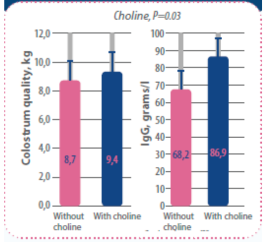
Graph 3. Quality (brix) and quantity of colostrum in cows supplemented with choline and without choline (Zenobi et al., 2018 – JDS 101_1088).
 In summary, research indicates that supplementing cows with choline during the transition period yields positive effects beyond merely preventing fat accumulation in the liver: In summary, research indicates that supplementing cows with choline during the transition period yields positive effects beyond merely preventing fat accumulation in the liver:
|
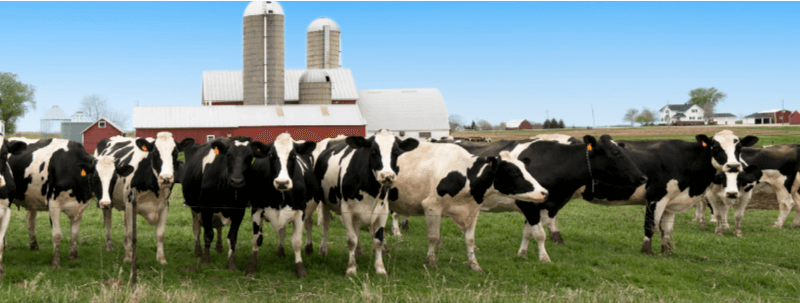
Bibliographical references
Drackley, J. K. 1999. ADSA Foundation Scholar Award: Biology of dairy cows during the transition period: The final frontier? J. Dairy Sci. 82:2259–2273.
Herdt, T. H. 2000. Ruminant adaptation to negative energy balance. Influences on the etiology of ketosis and fatty liver. Vet. Clin. North Am. Food Anim. Pract. 16:215–230.
J. A. A. McArt, D. V. Nydam, and G. R. Oetzel 2012. Epidemiology of subclinical ketosis in early lactation dairy cattle.
J. M. Bollatti, M. G. Zenobi, B. A. Barton,2 C. R. Staples, and J. E. P. Santos 2019. Responses to rumen-protected choline in transition cows do not depend on prepartum body condition.
Puppel, K., Gołębiewski, M., Solarczyk, P., Grodkowski, G., Slósarz, J., Kunowska-Slósarz, M., … & Kuczyńska, B. (2019). The relationship between plasma β-hydroxybutyric acid and conjugated linoleic acid in milk as a biomarker for early diagnosis of ketosis in postpartum Polish Holstein-Friesian cows. BMC veterinary research,
U. Arshad, M. G. Zenobi, C. R. Staples, and J. E. P. Santos 2019. Meta-analysis of the effects of supplemental rumen-protected choline during the transition period on performance and health of parous dairy cows.
Zenobi, M. G., R. Gardinal, J. E. Zuniga, L. K. Mamedova, B. J. Bradford, J. P. Driver, B. A. Barton, J. E. P. Santos, C. D. Nelson, and C. R. Staples. 2020. Effect of prepartum energy intake and supplementation with ruminally-protected choline on innate and adaptive immunity of multiparous Holstein cows. J. Dairy Sci. 103:2200–2216
Zenobi, M. G., T. L. Scheffler, J. E. Zuniga, M. B. Poindexter, S. R. Campagna, H. F. Castro Gonzalez, A. T. Farmer, B. A. Barton, J. E. P.
Santos, and C. R. Staples. 2018. Feeding increasing amounts of ruminally protected choline decreased fatty liver in nonlactating, pregnant Holstein cows in negative energy status. J. Dairy Sci. 101:5902–5923.
Subscribe now to the technical magazine of animal nutrition
AUTHORS

Hybrid Rye Potential in Laying Hen Feed Rations
Gwendolyn Jones
A day in the life of phosphorus in pigs: Part I
Rafael Duran Giménez-Rico
Use of enzymes in diets for ruminants
Braulio de la Calle Campos
Minerals and Hoof Health in the Pregnant Sow
Juan Gabriel Espino
Impact of Oxidized Fats on Swine Reproduction and Offspring
Maria Alejandra Perez Alvarado